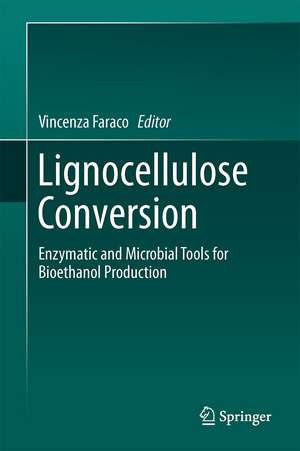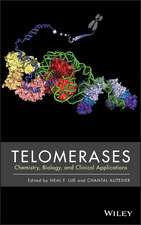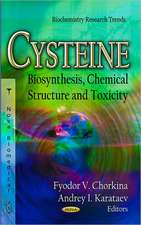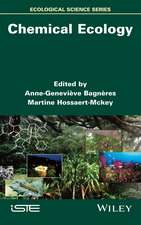Lignocellulose Conversion: Enzymatic and Microbial Tools for Bioethanol Production
Editat de Vincenza Faracoen Limba Engleză Hardback – 26 iun 2013
| Toate formatele și edițiile | Preț | Express |
|---|---|---|
| Paperback (1) | 940.57 lei 6-8 săpt. | |
| Springer Berlin, Heidelberg – 16 iul 2015 | 940.57 lei 6-8 săpt. | |
| Hardback (1) | 944.99 lei 6-8 săpt. | |
| Springer Berlin, Heidelberg – 26 iun 2013 | 944.99 lei 6-8 săpt. |
Preț: 944.99 lei
Preț vechi: 1152.43 lei
-18% Nou
Puncte Express: 1417
Preț estimativ în valută:
180.85€ • 188.11$ • 149.30£
180.85€ • 188.11$ • 149.30£
Carte tipărită la comandă
Livrare economică 15-29 aprilie
Preluare comenzi: 021 569.72.76
Specificații
ISBN-13: 9783642378607
ISBN-10: 3642378609
Pagini: 200
Ilustrații: X, 199 p. 8 illus., 4 illus. in color.
Dimensiuni: 155 x 235 x 20 mm
Greutate: 0.43 kg
Ediția:2013
Editura: Springer Berlin, Heidelberg
Colecția Springer
Locul publicării:Berlin, Heidelberg, Germany
ISBN-10: 3642378609
Pagini: 200
Ilustrații: X, 199 p. 8 illus., 4 illus. in color.
Dimensiuni: 155 x 235 x 20 mm
Greutate: 0.43 kg
Ediția:2013
Editura: Springer Berlin, Heidelberg
Colecția Springer
Locul publicării:Berlin, Heidelberg, Germany
Public țintă
ResearchCuprins
Introduction: Potential of Cellulosic Ethanol.- Sources for Lignocellulosic Raw Materials for the Production of Ethanol.- The Pretreatment Step in Lignocellulosic Biomass Conversion: Current Systems and New Biological Systems.- The Saccharification Step: Trichoderma Reesei Cellulase Hyper Producer Strains.- The Saccharification Step: the Main Enzymatic Components.- Extremophilic (Hemi)cellulolytic Microorganisms and Enzymes.- The Alcohol Fermentation Step: the Most Common Ethanologenic Microorganisms Among Yeasts, Bacteria and Filamentous Fungi.- Other Ethanologenic Microorganisms.- Consolidated Bioprocessing for Improving Cellulosic Ethanol Production.
Textul de pe ultima copertă
Lignocellulose conversion stands out as a key process for the sustainable production of renewable fuels and chemicals. The use of lignocellulosic materials for second generation ethanol production makes it possible to minimize the conflict between land use for food (and feed) and energy production. The lignocellulosic raw materials are less expensive and they present a more even geographical distribution than does conventional agricultural feedstock. Residual biomass such as agro-industrial wastes, agricultural and forest crop residues and the organic and paper fractions of municipal solid waste make up a large percentage of lignocelluloses. Moreover, second generation ethanol production and use show lower greenhouse gas emissions than the first generation fuels, reducing environmental impacts, particularly in terms of climate change.
Lignocellulose conversion into ethanol commonly involves a pretreatment to remove the barrier of lignin and expose plant cell wall polysaccharides, enzymatic saccharification of sugars with a cocktail of cellulolytic and hemicellulolytic enzymes, and fermentation of the sugars with ethanologenic microorganisms. The commercialization of the process to produce cellulosic ethanol is still limited due to the high costs of current technologies, above all the (hemi)cellulolytic enzymes required to hydrolyze the polysaccharides. The enzymatic hydrolysis may take place in a separate step followed by fermentation called separate hydrolysis and fermentation, or it may take place together with the fermentation in a simultaneous saccharification and fermentation of hexoses process or simultaneous saccharification and co-fermentation of both hexoses and pentoses. The ultimate objective is one-step consolidated bioprocessing of lignocellulose into bioethanol, in which all the steps take place in a single reactor where a single micro-organism or microbial consortium converts pre-treated biomass into ethanol.
This book presents the main tools, the current technological developments and future prospects in cellulosic ethanol production and research.
Lignocellulose conversion into ethanol commonly involves a pretreatment to remove the barrier of lignin and expose plant cell wall polysaccharides, enzymatic saccharification of sugars with a cocktail of cellulolytic and hemicellulolytic enzymes, and fermentation of the sugars with ethanologenic microorganisms. The commercialization of the process to produce cellulosic ethanol is still limited due to the high costs of current technologies, above all the (hemi)cellulolytic enzymes required to hydrolyze the polysaccharides. The enzymatic hydrolysis may take place in a separate step followed by fermentation called separate hydrolysis and fermentation, or it may take place together with the fermentation in a simultaneous saccharification and fermentation of hexoses process or simultaneous saccharification and co-fermentation of both hexoses and pentoses. The ultimate objective is one-step consolidated bioprocessing of lignocellulose into bioethanol, in which all the steps take place in a single reactor where a single micro-organism or microbial consortium converts pre-treated biomass into ethanol.
This book presents the main tools, the current technological developments and future prospects in cellulosic ethanol production and research.
Caracteristici
Highlights the latest enzymatic and microbial tools for lignocellulose conversion Describes the route towards second generation bioethanol production All authors are eminent scientists well known for their work and expertise in the field? Includes supplementary material: sn.pub/extras















